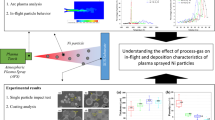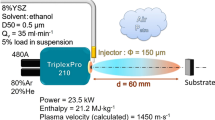Abstract
In this paper, a computational model based on supersonic plasma spraying (SAPS) is developed to describe the plasma jet coupled with the injection of carrier gas and particles for SAPS. Based on a high-efficiency supersonic spraying gun, the 3D computational model of spraying gun was built to study the features of plasma jet and its interactions with the sprayed particles. Further the velocity and temperature of in-flight particles were measured by Spray Watch 2i, the shape of in-flight particles was observed by scanning electron microscope. Numerical results were compared with the experimental measurements and a good agreement has been achieved. The flight process of particles in plasma jet consists of three stages: accelerated stage, constant speed stage and decelerated stage. Numerical and experimental indicates that the H2 volume fraction in mixture gas of Ar + H2 should keep in the range of 23–26 %, and the distance of 100 mm is the optimal spraying distance in Supersonic atmosphere plasma spraying. Particles were melted and broken into small child particles by plasma jet and the diameters of most child particles were less than 30 μm. In general, increasing the particles impacting velocity and surface temperature can decrease the coating porosity.















Similar content being viewed by others
Abbreviations
- ρ g :
-
Heavy particles density (kg/m3)
- \(\vec{V}_{g}\) :
-
Heavy particles velocity vector (m/s)
- dt :
-
Infinitesimal time
- n i :
-
The ith species particles number per unit volume (m−3)
- \(\vec{V}_{i}\) :
-
The ith species particles velocity (m/s)
- dω i :
-
The ith species particles change rate per unit volume (m−3)
- Fν t :
-
Volume force term which equal to the total force of mass force, electric field force and Lorentz force (N)
- P g :
-
Gas pressure (N/m2)
- μ :
-
Gas dynamic viscosity (Pa s)
- \([\dot{\varepsilon }]\) :
-
Strain rate tensor
- \(\vec{E}\) :
-
Electric current density (N/C)
- \(\vec{J}\) :
-
Electric current density (A/m2)
- ɛ :
-
Internal energy (J)
- \(\vec{q}\) :
-
Heat through unit area in unit time (J)
- ρ e :
-
Charge density (C/m3)
- \(\vec{A}\) :
-
Magnetic vector potential
- μ m :
-
Magnetic permeability of medium (H/m)
- μ 0 :
-
Vacuum magnetic permeability of medium (H/m)
- σ e :
-
Electrical conductivity (s/m)
- ϕ :
-
Electric potential (V)
- \(\vec{J}_{\text{U}}\) :
-
The other source term
- \(\vec{u}_{e}\) :
-
Velocity of charged particles (m/s)
- \(\vec{B}\) :
-
Magnetic induction intensity (T)
- ψ :
-
Convective heat-transfer coefficient
- \(\vec{F}_{L}\) :
-
Lorentz force (N)
- m d :
-
Particle mass (kg)
- \(\vec{\upsilon }\) :
-
Particle velocity vector (m/s)
- C D :
-
Gas drag coefficients
- \(\vec{U}\) :
-
Gas velocity vector (m/s)
- A d :
-
Droplet frontal area (m2)
- Re :
-
Reynolds number
- F p :
-
Forces on particle (N)
- d p :
-
Particle diameter (m)
- F T :
-
Thermophoretic force (N)
- K g :
-
Gas thermal conductivity (W/m K)
- K p :
-
Particle thermal conductivity (W/m K)
- C 1 :
-
Constant number, C 1 = 1.17
- C 2 :
-
Constant number, C 2 = 1.14
- C 3 :
-
Constant number, C 3 = 2.18
- ∇T :
-
Temperature gradient (K)
- Kn :
-
Knudsen number
- T:
-
Temperature (K)
- Pr s :
-
Prandel number of plasma gas evaluated at the surface temperature
- ρ s :
-
Mean density of gas phase around the particle (kg/m3)
- K f :
-
Film temperature defined as the average value of gas temperature at cell where the particle is located and at the immediate vicinity by the particle surface (K)
- c p,f :
-
Film specific heat capacity (J/kg K)
- H :
-
Particle enthalpy (J/kg)
- r p :
-
Particle radius (m)
- T f :
-
Gas temperature surrounding the particles (K)
- T s :
-
Particle surface temperature (K)
- k :
-
Boltzmann constant
- ζ :
-
Emission coefficient
- Q vap :
-
Energy dissipation by particle evaporation
- A V :
-
The coefficient of finite volume V
- A V′ :
-
Coefficient of adjacent volume element
- S U :
-
Source term
- \(\phi\) :
-
Variables
- φ :
-
The radiation coefficient of particle
- E ra :
-
Radiation energy (J)
- λ :
-
The flame wavelength (nm)
- λ 1, λ 2 :
-
Selected wavelength
- C 1, C 2 :
-
Constant
- Oh :
-
Ohnesorge number
- ρ p,L :
-
Particles density in liquid phase
- σ p :
-
Droplet surface tension coefficient
- ρ c :
-
Coating density (kg/m3)
- ρ r :
-
Relative density of coating (kg/m3)
- Po :
-
Porosity of coating
- i :
-
The ith species particles
- g :
-
Gas
- p :
-
Particle
- s :
-
Particle surface
- t :
-
Total
- f :
-
Film
- c :
-
Coating
- r :
-
Relative
- ra :
-
Radiation
- L :
-
Liquid
- V :
-
Volume
- V′ :
-
Adjacent volume
- T :
-
Temperature
- vap :
-
Evaporation
- d :
-
Droplet
- D:
-
Drag
- e :
-
Charged particle
- m :
-
Medium
- U:
-
Source
References
Zhu S, Xu BS, Yao JK (2005) High quality ceramic coatings sprayed by high efficiency hypersonic plasma spraying gun. Mater Sci Forum 3981:475–479
Han ZH, Xu BS, Wang HJ, Zhou SK (2007) A comparison of thermal shock behavior between currently plasma spray and supersonic plasma spray CeO2–Y2O3–ZrO2 graded thermal barrier coatings. Surf Coat Technol 201:5253–5256
Zhang XC, Xu BS, Tu ST, Xuan FZ, Wang HD, Wu YX (2008) Porosity, mechanical properties, residual stresses of supersonic plasma-sprayed Ni-based alloy coatings prepared at different powder feed rates. App Surf Sci 254:3879–3889
Vardelle A, Fauchais P, Dussoubs B, Themelis NJ (1998) Heat generation and particle injection in a thermal plasma torch. Plasma Chem Plasma Process 18:551–574
Fang JC, Xu WJ, Zhao ZY, Wang L (2007) In-flight behaviors of ZrO2 particle in plasma spraying. Surf Coat Technol 201:5671–5675
Guessasma S, Montavon G, Coddet C (2005) Velocity and temperature distributions of alumina–titania in-flight particles in the atmospheric plasma spray process. Surf Coat Technol 192:70–76
Kubel EJ (1990) Powders dictate thermal-spray-coating properties. ADV Mater Process 12:24–32
Vardelle M, Vardelle A, Fauchais P, Li KI, Dussoubs B, Themelis NJ (2001) Controlling particle injection in plasma spraying. J Therm Spray Technol 10:267–284
Vaidya A, Streibl T, Li L, Sampath S, Kovarik O, Greenlaw R (2005) An integrated study of thermal spray process–structure–property correlations: a case study for plasma sprayed molybdenum coatings. Mater Sci Eng A 403:191–204
Srinivasan V, Friis M, Vaidya A, Streibl T, Sampath S (2007) Particle injection in direct current air plasma spray: salient observations and optimization strategies. Plasma Chem Plasma Process 27:609–623
Zhang W, Zheng LL, Zhang H, Sampath S (2007) Study of injection angle and carrier gas flow rate effects on particles in-flight characteristics in plasma spray process: modeling and experiments. Plasma Chem Plasma Process 27:701–716
Datta S, Pratihar DK, Bandyopadhyay PP (2012) Modeling of input-output relationships for a plasma spray coating process using soft computing tools. Appl Soft Comput 12:3356–3368
Liu B, Zhang T, Gawne DT (2000) Computer modelling of the influence of process parameters on the heating and acceleration of particles during plasma spraying. Surf Coat Technol 132:233–243
Marchand C, Chazelas C, Mariaux G, Vardelle A (2007) Liquid precursor plasma spraying: modeling the interactions between the transient plasma jet and the droplets. J Therm Spray Technol 16:705–712
Ahmed I, Bergman TL (2000) Three-dimensional simulation of thermal plasma spraying of partially molten ceramic agglomerates. J Therm Spray Technol 9:215–224
Wei P, Wei Z, Li S, Tan C, Du J (2014) Splat formation during plasma spraying for 8 mol% yttria-stabilized zirconia droplets impacting on stainless steel substrate. Appl Surf Sci 321:538–547
Ahmed I, Bergman TL (2006) Optimization of plasma spray processing parameters for deposition of nanostructured powders for coating formation. J Fluid Eng Trans ASME 128:394–401
Li L, Vaidya A, Sampath S (2006) Particle characterization and splat formation of plasma sprayed zirconia. J Therm Spray Technol 15:97–105
Zhang H, Wei G, Zheng L (2003) Numerical and experimental studies of substrate melting and re-solidification during thermal spraying. J Mater Sci Technol 9:137–140
Lajun F, Kaibo C, Ali L (2007) Numerical simulation on calefaction and acceleration process of ceramic powders in plasma spray. Hot Work Technol 35:46–51
Li HP, Chen X (2001) Three-dimensional simulation of a plasma jet with transverse particle and carrier gas injection. Thin Solid Films 390:175–180
Zhao WT, Wu JH, Bai Y (2013) Melting refining mechanisms in supersonic atmospheric plasma spraying. Plasma Chem Plasma Process 32:1227–1242
Fusheng HU, Zhengying WEI, Bolin LIU (2013) Numerical analysis of spraying process with high efficiency atmospheric supersonic plasma gun. Mater Sci Technol 21:137–142
Fusheng H, Zhengying W, Liu Bolin D, Jun TC, Zhihai H (2012) Three dimensional numerical analysis of plasma spraying using supersonic plasma gun. Appl Mech Mater 190:222–226
Chang CH, Ramshaw JD (1993) Numerical of simulation of argon plasma jet flowing into cold-air. Plasma Chem Plasma Process 13:189–209
Cheng K, Chen X (2004) Prediction of the entrainment of ambient air into a turbulent argon plasma jet using a turbulence-enhanced combined-diffusion-coefficient method. Int J Heat Mass Transf 47:5139–5148
Zhang W (2008) Integration of process diagnostics and three dimensional simulations in thermal spraying. Stony Brook University, Stony Brook
Ramachandran K, Nishiyama H (2002) Three-dimensional effects of carrier gas and particle injections on the thermo-fluid fields of plasma jets. J Phys D Appl Phys 35:307–317
Talbot L (1981) Thermophoresis—a review rarefied gas dynamics. AIAA Book, New York
Patterson MA, Reitz RD (1998) Modeling the effects of fuel spray characteristics on diesel engine combustion and emissions. SAE Paper 980131. J Engines 107:27–43
Issa RI (1985) Solution of the implicitly discretized fluid flow equations by operator-splitting. J Comput Phys 62:40–65
Liu B, Zhang T, Gawne DT (2000) Computational analysis of the influence of process parameters on the flow field of a plasma jet. Surf Coat Technol 132:202–216
Amsden AA, O’Rourke PJ, Butler TD (1989) KiVA-II: a computer program for chemically reactive flows and fuel sprays. In Report LA-11560-MS Los Alamos National Laboratory
Joseph DD, Belanger J, Beavers GS (1999) Breakup of a liquid drop suddenly exposed to a high-speed airstream. Int J Multiphase Flow 25:1263–1303
Acknowledgments
This work was supported by State Key Laboratory for Mechanical Behavior materials. Thanks to the help of Supersonic Plasma Spraying Laboratory of Xi’an Jiaotong University.
Author information
Authors and Affiliations
Corresponding author
Rights and permissions
About this article
Cite this article
Wei, P., Wei, Z., Zhao, G. et al. Flow characteristic of in-flight particles in supersonic plasma spraying process. Heat Mass Transfer 52, 1739–1753 (2016). https://doi.org/10.1007/s00231-015-1693-1
Received:
Accepted:
Published:
Issue Date:
DOI: https://doi.org/10.1007/s00231-015-1693-1




